Journal of Yoga & Physical Therapy
Open Access
ISSN: 2157-7595
ISSN: 2157-7595
Review Article - (2021)
Background: Physical inactivates is one of the major factors to compromise physical activities and lead to functional disability and pain. Common structures that get involved in human mechanics are the Neck and Shoulder. Exercises, yoga and lifestyle modification remains the essential part to enhance structural stability and functional mobility. Situations like pandemic where Telephysiotherapy observes great scopes in management. Thus, we would like to find out the impact of Telephysiotherapy to deliver "physioyoga" for people with neck pain.
Methodology: Digital flyers have been circulated on social media. Volunteers have been selected based on selection criteria. Total 4 weeks of Telephysiotherapy intervention where Volunteers are redistributed into mild, moderate, and severe groups according to Neck Disability Index Score. Participants had 2 supervised sessions and 21 nonsupervised sessions per week for 4 weeks of intervention and a minimum of 14 sessions per week. Based on the severity and subject-specific Physio-yoga prescribed to Participants and assessed at end of every week for changes in the outcome measure.
Result and discussion: Null hypothesis is rejected and there is a significant difference seen.
Conclusion: We conclude there is an impact of Telephysiotherapy on people with neck and shoulder pain
Activities of Daily Livings (ADLs) involve several activities including sit to stand, walking, climbing, grooming, bathing, and many more where every component of human structures matters equally important. Physical inactivates will be one of the major factors to compromise physical activities and lead to functional disability and pain. One of the most common structures that get involved in human mechanics is the Neck and Shoulder. 75% of people in their life span observe neck pain and 85% are non-structural causes of pain and loss of function Neck pain is a musculoskeletal condition that is due to overuse of a muscle or due to the constant position or posture of people. These may lead to tightening or weakness of muscles. This may lead to an imbalance of muscle or a decrease in activation of muscle. When these muscles are not stimulated to resist gravity for an extended period, either stabilizing ``function is disturbed by the hypoactivity reaction resulting in muscular weakness and atrophy [1,2]. The deficit of the locomotor system stability triggers a compensatory mechanism—the stabilizing function is overtaken by the mobilizing muscles. However, as a side effect, such compensation leads to mobilizers’ increased activity (hyperactivity) and, subsequently, their decreased flexibility, which may finally lead to a pathological chain of reactions within the musculoskeletal system. Many structures in the neck are richly innervated with C fibres and A-delta fibres. Local pressure can mechanically activate these nerves. These neurons can be excited by naturally occurring inflammatory agents, including substance P and phospholipase A. Massive input of noxious stimuli from injury causes physiologic changes in the dorsal horn, implicating excitatory amino acid. Widows who have low salary and perform occupational activities such as sitting have chances of neck pain. The global community experienced devastating consequences from the first report of the novel severe acute respiratory syndrome named “Corona virus” in Wuhan, Hubei Province of China on December 31st, 2019 [1-6]. Covid -19 outbreak was declared a pandemic by the world health organization (WHO) in March 2020(1). During the Covid-19situation, all the importance was held to regulate the high intense condition by the government. These lead to the barrier in a profession like physiotherapy who is usually in close contact with a patient needing low-intensity care [2-7].
Fundamental movement through emerging technologies created changes in way of thinking [3-9]. The importance of recommendation on the future of digital-physical therapist practice developed by the World Confederation for Physical Therapy (WCPT) with the International Network of Physiotherapy Regulatory Authorities, offering to the community of physical therapists the opportunity to reflect on this new method of care delivery [2-11]. Telerehabilitation has already introduced or expanded resources and advice to implement at the national level, different member organizations [2]. To facilitate independent rehabilitation of patients within their freedom by the development of telemonitoring systems is called “Telephysiotherapy” [4-13]. There are different forms of telecommunication used to treat a patient through Telephysiotherapy such as video conference, telephone-based, messages, email, etc which can be used to fulfill the goal of treatment [3-15].
Yoga has been a part of our Indian culture from the beginning which helps people to increase flexibility and strengthen weakened muscles. Yoga has been combined with exercise and named “Physioyoga”. Yoga is the set of “static-dynamic procedures”. Yoga, as well as physiotherapy, releases somatic dysfunction.
This study was an interventional study, an online mode where participants can participate in a comfortable environment. The study duration was one month starting from 6th January 2021 to 28th February 20121 and it was approved by the ethical committee of the School of physiotherapy, RK University. Telephonic verbal consent was taken.
Data collection
An interventional study where digital flyers will be circulated on social media to avail of Telephysiotherapy with "physio-yoga" for functional disabilities and pain in the neck and shoulder, volunteers will be selected based on selection criteria such as Neck Disability Index (NDI) Score – Greater than or equal to 10% and less than or equal to 64 %, Age between 20 to 65 years, and no history of hospitalization in the last six months. Total 4 weeks of Telephysiotherapy intervention where Volunteers will be redistributed into mild, moderate, and severe groups according to Neck Disability Index Score. Participants will have 2 supervised sessions and 21 non-supervised sessions per week for 4 weeks of intervention and a minimum of 14 sessions per week to be eligible for statistical analysis. Based on the severity and subject-specific Physioyoga will be prescribed to Participants and assessed every week (end of 1st, 2nd, 3rd, and 4th week) for changes in Neck Disability index and Numerical pain rating scale.
Intervention – Physioyoga is the combination of exercise and staticdynamic procedure and following Physioyoga are used to cure the pain and functional ability of patients with neck pain.
1. Trunk rotation
2. Thoracic extension
3. Neck bending with chin tuck
4. Chin tuck
5. Butterfly exercise
Statistical analysis
After the collection of data, data were analyzed by SPSS software, and the result was found. SPSS version 20 was used for data analysis. Microsoft excels and the word was used to generate graphs.
The graph shows the estimated marginal means of the NDI score of all four weeks starting from day 1. Mean of day 1, week 1, week 2, week 3 and week 4 is 38.05, 33.55, 29.31, 26.68, and 25.03
The graph shows the estimated marginal means of NPRS of all four weeks starting from day 1. The mean of day 1, week 1, week 2, week 3, and week 4 is 6, 5, 5, 4, 4.
By Repeated measure, ANOVA the value of Wilk's lambda showing the significance of 0.000 through the multivariate test of both NDI and NPRS multivariate test of both NDI and NPRS (Tables 1-5 and Figures 1-9).
| Multivariate test of NPRS | |
| Sig. | |
| Wilk’s lambda | 0.000 |
Table 1 Multivariate Test of NPRS
| Multivariate test of NDI | |
| Sig. | |
| Wilk’s lambda | 0.000 |
Table 2 Multivariate Test of NDI
| Severity | Day 1 | Week1 | Week 2 | Week3 | Week4 |
| Mild | 10 | 14 | 17 | 16 | 17 |
| Moderate | 15 | 12 | 10 | 11 | 10 |
| Severity | 5 | 4 | 3 | 3 | 3 |
Table 3 Severity Based
| Correlations | |||
| Day | Week 4 | ||
| Day 1 | Pearson Correlation | 1 | .901** |
| Sig. (2-tailed) | .000 | ||
| N | 30 | 30 | |
| Week 4 | Pearson Correlation | .901** | 1 |
| Sig. (2-tailed) | .000 | ||
| N | 30 | 30 | |
Table 4: Correlation of Ndi.
| Correlations | |||
| Nprs1 | Nprs28th | ||
| Nprs1 | Pearson Correlation | 1 | .894** |
| Sig. (2-tailed) | .000 | ||
| N | 30 | 30 | |
| Nprs28th | Pearson Correlation | .894** | 1 |
| Sig. (2-tailed) | .000 | ||
| N | 30 | 30 | |
Table 5: Correlations of Nprs.
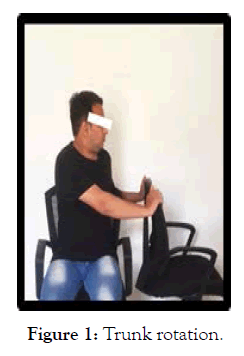
Figure 1. Trunk rotation.
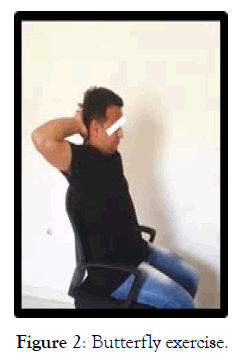
Figure 2. Butterfly exercise.
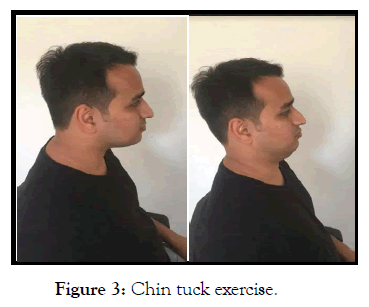
Figure 3. Chin tuck exercise.
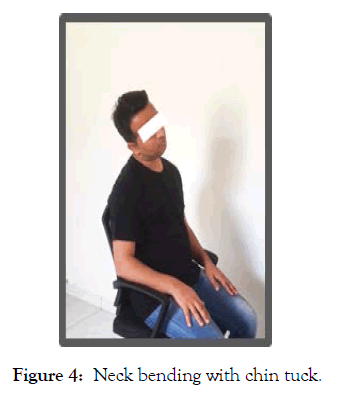
Figure 4. Neck bending with chin tuck.
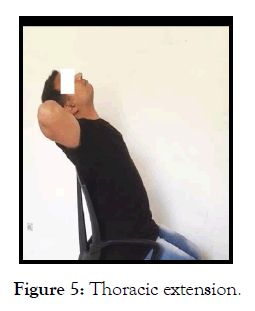
Figure 5. Thoracic extension.
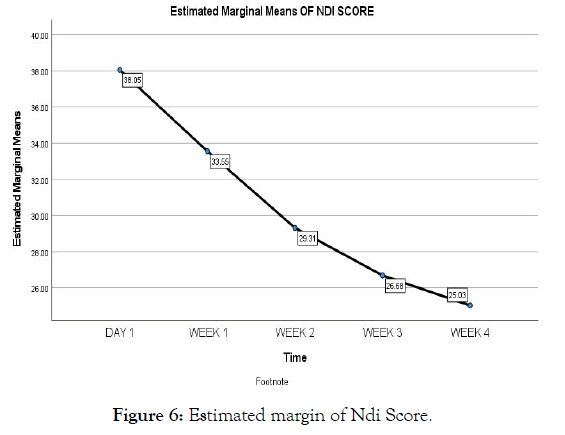
Figure 6. Estimated margin of Ndi Score.
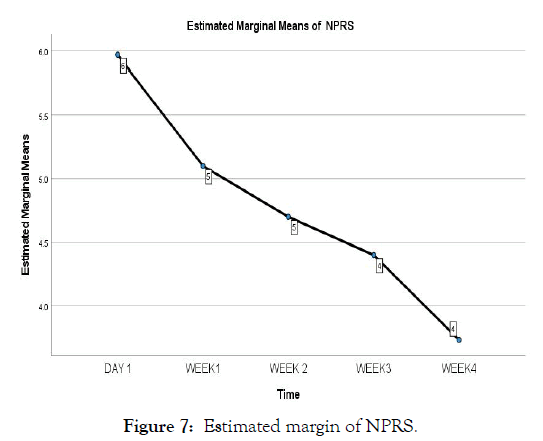
Figure 7. Estimated margin of NPRS.
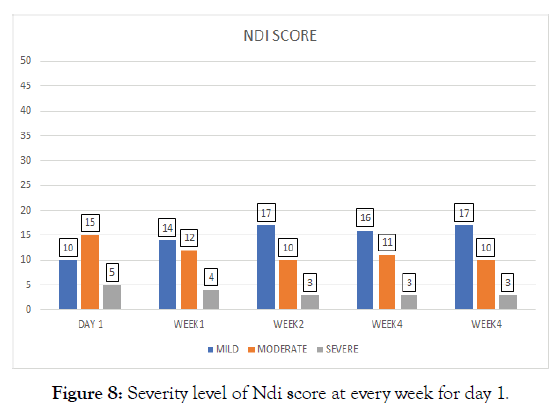
Figure 8. Severity level of Ndi score at every week for day 1.
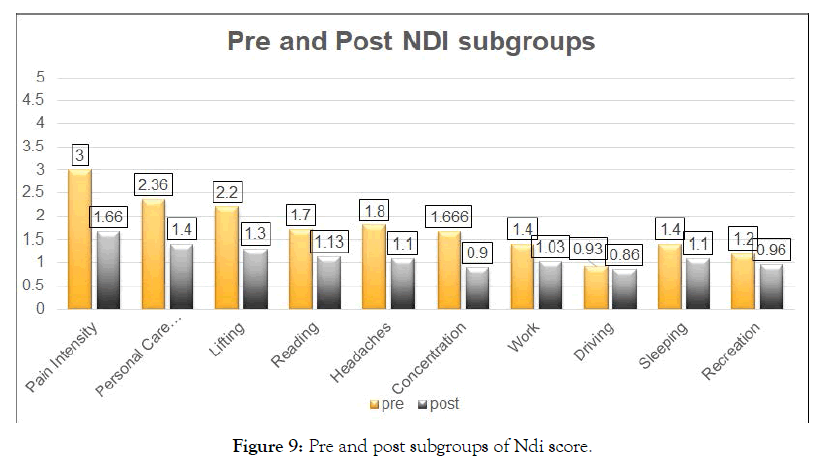
Figure 9. Pre and post subgroups of Ndi score.
The graph shows the severity level of NDI of Day1, week1, week2, week3, and week4. Where mild is shown in blue colour, moderate in orange colour, and severe in grey colour, mild severity shown on day1, week1, week2,week3,week4 is 10,14,17,16,17. Moderate severity shown on day1, week1, week2,week3,week4 is 15,12,10,11,10. Severe severity shown on day1, week1, week2, week3, week4 is 5, 4, 3, 3, 3. As the week passes and at the end of the 4th week the number of mild severity patients increases compared to moderate or severe. Hence, we can prove a positive shift seen in the severity of the patient.
The graph shows the mean of pre and post-NDI subgroups where the Y-axis shows the subgroups of NDI and the X-axis shows the mean points of subgroups there were significant changes seen in pain intensity. Subjects showed a decrease in pain by the physio yoga provided through telephysiotherapy. Pain intensity went from 3 to 1.66. Additional changes were seen in personal care, lifting, headache. Personal care showed a positive shift from 2.36 to 1.4. Lifting showed changes from 2.2 to 1.3.
The correlation test shows a correlation between day1 and day 28th of NDI and NPRS.
The study investigated the impact of Telephysiotherapy to deliver Physioyoga for improving the functional ability and pain in the neck and shoulder. The intervention showed a significant reduction in pain as well as functional abilities. Telephysiotherapy intervention through social media such as WhatsApp, Instagram, and zoom seemed to be a feasible option where high technology is beyond the reach of people, and the literacy rate is low
Our study demonstrated a significant reduction in pain in 'mild', 'moderate', 'severe' conditions after Telephysiotherapy. Graph of estimated marginal means of NDI showed a higher mean at day 1. There was a gradual decrease in NDI score at week1, week2, week 3, and week4. Hence, there was a decrease in the marginal means at week 4. Graph 6.2 estimated marginal means of NPRS showed a decrease in the points at the end of week 4. There was a significant difference seen from day1 to week4. Females were more compared to males. Age from 41-50 showed a higher prevalence of neck pain.
Pearson correlation showed a significant difference in NDI and NPRS. At the end of the 4th week, a significant difference was seen as there was a decrease in the score of NDI. There was a decrease in severity. Positive results were seen in overall treatment. Pre and Post NDI subgroups showed that there was a significant positive change in pain intensity, personal care, and lifting which are chief complaints of the patient. One of the components such as driving didn't show many changes, so Telephysiotherapy should be optimized to see positive change in driving.
In contrast, the functional (neurological) approach to musculoskeletal problems is based on the interaction of the central and peripheral nervous systems, and the involvement of the muscular and skeletal structures in producing and controlling motion. In this functional approach, the musculoskeletal problems are attributed to the role of muscles in motor function; furthermore, changes in the alignment result not only from changes in muscle length and strength but also from more important changes in muscle neuromuscular factors, such as muscle recruitments]. The motor control unit may change the muscle activation strategy for temporary stabilization due to the presence of dysfunction. These changes in motor recruitment will alter the muscular balance, movement patterns, and eventually the motor program]. Similarly, Hodges et al. noted that motor control interventions require tailoring to each individual’s posture, muscle activation, and movement pattern.
A self-automated consulting app should be used to deliver Physioyoga.
Citation: Jodhpura H, Rathod P (2021) Impact of Telephysiotherapy to Deliver Physioyoga for Improving the Functional Ability and Pain in the Neck and Shoulder. J Yoga Phys Ther.11:366. Doi:10.35248/2157-7595.21.11.366
Received: 03-Aug-2021 Accepted: 19-Aug-2021 Published: 30-Aug-2021 , DOI: 10.35248/2157-7595.21.11.366
Copyright: © 2021 Jodhpura H, et al. This is an open-access article distributed under the terms of the Creative Commons Attribution License, which permits unrestricted use, distribution, and reproduction in any medium, provided the original author and source are credited.